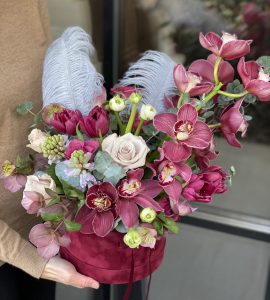Flowers are a universal gift that can please any person with a show of attention. An exception is made by people with allergies to flowers: even the most beautiful composition, composed with love and awe, at best, will cause a runny nose among allergy sufferers and ruin the holiday. However, this does not mean that a girl with a specific body reaction to flowers will have to be left without floristic surprises: knowing what varieties can be given to allergy sufferers, you can choose the right bouquet and make the gift safe, and the celebration even more joyful.
Allergy symptoms appear due to the fact that the body mistakenly recognizes a foreign protein in plant pollen and tries to defend itself against it. The main danger for allergy sufferers is represented by flowers with light pollen, which, from the slightest movements, rises into the air and irritates the mucous membrane of the respiratory tract. Small pollen is very often combined with a pronounced aroma, so if you are not sure whether the recipient of flowers has allergies, it is better not to give strong-smelling plants. In addition, the bright scent of flowers can cause headaches.
Almost all cereals belong to strong allergens, so it is better not to add rye, wheat and other spikelets to bouquets. Fern decor should also be avoided.
Modern breeders are working on breeding entirely hypoallergenic varieties of plants that are guaranteed not to cause an immune response, even with a bright aroma. One of these flowers is the decorative Cappucino sunflower. Large flower shops make sure that their assortment includes hybrid varieties of plants that have a minimal risk of developing allergies.
Plants with a delicate aroma or those that have no odor at all are considered the least dangerous in terms of immune reactions. The pollen of hypoallergenic plant varieties is usually heavy, due to which it almost does not rise into the air, and its amount is minimal.
If the immune reaction of the person to whom you want to give flowers is very pronounced, it is better not to risk it and give a basket of fruits instead of a flower arrangement. Another alternative to flowers is sweet bouquets: you can add a soft toy or other pleasant surprise to them.
If the girl certainly wants to please with a living plant, instead of cut flowers, you can donate indoor ones. Potted flowers, which are not allergic, will delight the recipient with their beauty many times longer than a fresh bouquet.
The rules for choosing indoor plants are no different from the recommendations for choosing bouquets: during the flowering period, domestic crops should not exude a pungent odor and fine pollen. The best candidates for the role of a new flower for an allergic person will be non-flowering species with smooth leaves, terry plant varieties and natives of the tropics: the number of stamens in densely double flowers is minimal, due to which pollen is practically not emitted, and tropical species like high humidity, “nailing” pollen to flower. If a girl likes a “dangerous” plant, it can be presented by placing it in a personal florarium.


